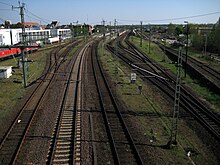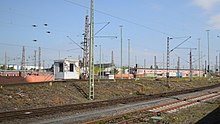Drain mountain

The hump (also Abrollberg , flow back , expiration hill , donkey or rare Rangierberg , in Austria Rollberg ) is an artificial hill usually through which a track runs. In larger drainage systems there are often two or more mountain tracks. Humps serve the impressions the draining of freight cars that are sorted in this way to their destinations. They can be found in marshalling yards as well as some freight , factory or port stations .
The trains to be disbanded are prepared manually on the entry track. The main air line is depressurized except for a possibly prescribed air peak (so that the pulling unit remains controllable when the trigger is pulled , a prescribed number of cars in front of the trigger locomotive is connected to the main air line), the brakes are released by pressing the release pulls . In networks with screw coupling, the coupling chains are made long at the points to be separated, any existing line connections are separated. Then this train unit is pushed up the drain mountain by a shunting locomotive, at the top of which the uncoupler ( loose hanger ) disconnects the couplings at the required points . The carriages then roll down the slope individually or in small coupled groups (the processes ) and driven by gravity. The turnouts in front of the incoming processes are set by the process control box in such a way that they run into the direction track in which the processes for the respective destination are collected. In particular, the turnouts of the first two series are equipped with high-speed drives with a changeover time of just 0.6 to 0.8 seconds. In old systems, the speed of the processes is regulated with drag shoes , for this purpose there are drag shoe ejection devices in the ramp tracks , usually with an automatic return through a conveyor belt. In the target tracks, further brake blocks brake the wagons or groups of wagons to such an extent that they reach the wagons that are already in the directional track, but do not run too hard. In mechanized marshalling yards, the speed is regulated by track brakes , which are divided into ramp, valley and direction track brakes according to their installation location. The decisive braking takes place in the ramp or valley brakes, which are regulated by the track brake attendant or an automated control system. The task of the other directional track and slope compensation brakes is in turn to slow down the processes to such an extent that they hit the stationary wagons in the target track with the permissible speed and ready for coupling. Poorly performing cars that do not reach their predecessors, by a switch engine or an automatic conveyor system ( Beidrückeinrichtung ) to the stationary vehicles introduced ( beige suppressed ). The advantage of automatic pressing devices is that the process does not have to be interrupted for their use. The wagons are coupled in the direction tracks and pulled into the exit group, where the train is completed and covered. However, there are also stations with a unified direction track group and exit group.
The height of a runoff mountain can be determined approximately from the rolling resistance of the car, in particular the resistance to bending in the distribution switches and bends. Typical are heights of two meters, the gradient to the direction tracks is 30 to 60 per thousand .
The plain bearings used in the past noticeably impaired the running properties of the wagons, especially in extremely cold weather. The main reason for this was the fact that the oil in the sliding axle bearings was much tougher in the cold season and the cars therefore had a higher rolling resistance. To compensate for this, two drainage mountains were often created next to each other, with the summer mountain being used in warm weather and the approximately 0.5–0.8 m higher winter mountain in cold weather. Strong wind also influences the speed of the processes, which is why the main wind direction must be taken into account when planning a drainage system.
The process operation is regulated by the trigger signal , which has become dispensable in modern and automated marshalling yards and is only a fall-back level.
Railway wagons that only reach a comparatively low speed when maneuvering over a mound and therefore stop before the intended destination are referred to as poor runners. The opposite is the case with good runners who need significantly more brake interventions on their way. Caution wagons are wagons with sensitive or dangerous cargo that may only pass with the handbrake engaged. The number of axles that can be controlled with an occupied handbrake is specified for regularly used drainage systems.


